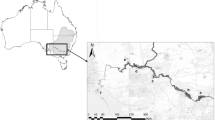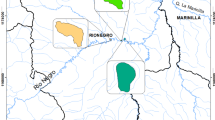Abstract
In the prairie pothole region, it is often assumed that relict seed banks in restored wetlands contain the seeds needed to re-establish their predrainage vegetation. This hypothesis was tested by comparing the composition of the seed banks of drained wetlands with those previously reported in undrained wetlands. Most of the species whose seeds were found in drained wetlands were annual or perennial herbs that are also found in undrained wetlands, primarily on exposed mudflats during drawdowns. Very few seeds of the emergent, free-floating or submersed species that dominate the seed banks and vegetation of undrained wetlands were found in the seed banks of drained wetlands. A second hypothesis was tested: the seed banks of drained floodplain wetlands have more species and seeds than those of drained palustrine wetlands. The seed banks of drained floodplain wetlands were significantly larger (mean total 1,660 seeds per sample, n = 10) than those in the drained palustrine wetlands (460 seeds per sample, n = 10). There was, however, no significant difference in the mean total number of species (26 and 29) or mean number of wetland species (18 and 18). The species composition of seed banks varied significantly among drained floodplain wetlands and among drained palustrine wetlands.
Similar content being viewed by others
References
Aronson MFJ, Galatowitsch SM (2008) Long-term vegetation development of restored prairie pothole wetlands. Wetlands 28:883–895
Bigwood DW, Inouye DW (1988) Spatial pattern analysis of seed banks: an improved method and optimized sampling. Ecology 69:497–507
Brock MA (2011) Persistence of seed banks in Australian temporary wetlands. Freshwater Biology 56:1312–1327
Cellot B, Monillot F, Henry CP (1998) Flood drift and propagule bank of aquatic macrophytes in a riverine wetland. Journal of Vegetation Management 9:631–640
Cook CDK (1987) Dispersion in aquatic and amphibious vascular plants. In: Crawford RMM (ed) Plant life in aquatic and amphibious habitats. Blackwell, Oxford, UK, pp 179–190
Danvind M, Nilsson C (1997) Seed floating ability and distribution of alpine plants along a northern Swedish river. Journal of Vegetation Management 8:271–276
Galatowitsch SM, van der Valk AG (1994) Restoring prairie wetlands: an ecological approach. Iowa State University Press, Ames
Galatowitsch SM, van der Valk AG (1996) The vegetation of restored and natural prairie wetlands. Ecological Applications 6:102–112
Gordon E, van der Valk AG (2003) Secondary seed dispersal in Montrichardia arborescens (L.) Scott dominated wetlands in Laguna Grande, Venezuela. Plant Ecology 168:177–190
Great Plains Flora Association (1986) Flora of the great plains. University Press of Kansas, Lawrence
Kettenring KM, Galatowitsch SM (2011) Seed rain of restored and natural prairie wetlands. Wetlands 31:283–294
Leck MA (1989) Wetland seed banks. In: Leck MA, Parker VT, Simpson RL (eds) Ecology of soil seed banks. Academic, New York, pp 283–305
Mitsch WJ, Wu X, Nairn RW, Weihe PE, Wang N, Deal R, Boucher CE (1998) Creating and restoring wetlands: a whole-ecosystem experiment in self-design. BioScience 48:1019–1029
Mueller MH, van der Valk AG (2002) The potential role of ducks in wetland seed dispersal. Wetlands 22:170–178
Mueller-Dombois D, Ellenberg H (1974) Aims and methods of vegetation ecology. John Wiley, New York
Mulhouse JM, Galatowitsch SM (2003) Revegetation of prairie potholes in the mid-continental US: twelve years after reflooding. Plant Ecology 169:143–159
Reed PB, Jr (1988) National list of plant species that occur in wetlands: national summary. U.S. Fish and Wildlife Service Biol. Rep. 88(24), Washington, DC, USA. 244 pp
Ridley HN (1930) The dispersal of plants throughout the world. Reeve, Ashford, Kent, UK
Schneider RL, Sharitz RR (1988) Hydrochory and regeneration in a bald cypress-water tupelo swamp forest. Ecology 69:1055–1063
Staniforth RJ, Cavers PB (1976) An experimental study of water dispersal in Polygonum spp. Canadian. Journal of Botany 54:25-87-2596
Toth LA (1993) The ecological basis of the Kissimmee River restoration plan. Floridaa Scientist 56:25–51
Toth LA, Arrington DA, Brady MA, Muszick DA (1995) Conceptual evaluation of factors potentially affecting restoration of habitat structure within the channelized Kissimmee River ecosystem. Restoration Ecology 3:160–180
van der Valk AG (1981) Succession in wetlands: a Gleasonian approach. Ecology 62:688–696
van der Valk AG (1992) Establishment, colonization and persistence. In: Glenn-Lewin DC, Peet RK, Veblen TT (eds) Plant succession: theory and prediction. Chapman and Hall, London, UK, pp 60–102
van der Valk AG (1998) Succession theory and restoration of wetland vegetation. In: McComb AJ, Davies JA (eds) Wetlands for the future. Gleneagles Publishing, Adelaide, Australia, pp 657–667
van der Valk AG, Davis CB (1976) The seed banks of prairie glacial marshes. Canadian Journal of Botany 54:1832–1838
van der Valk AG, Davis CB (1978) The role of seed banks in the vegetation dynamics of prairie glacial marshes. Ecology 59:322–325
van der Valk AG, Davis CB (1979) A reconstruction of the recent vegetational history of a prairie glacial marsh, Eagle Lake, Iowa, from its seed bank. Aquatic Botany 6:29–51
van der Valk AG, Pederson RL (1989) Seed banks and the management and restoration of natural vegetation. In: Leck MA, Parker VT, Simpson RL (eds) Ecology of soil seed banks. Academic, New York, pp 329–346
van der Valk AG, Rosburg TR (1997) Seed bank composition along a phosphorus gradient in the northern Florida Everglades. Wetlands 17:228–236
van der Valk AG, Toth LA, Gibney EB, Mason D, Wetzel PR (2009) Potential sources of propagules for reestablishing vegetation on the floodplain of the Kissimmee River, Florida, USA. Wetlands 29:976–987
Wetzel PR, van der Valk AG, Toth LA (2001) Restoration of wetland vegetation on the Kissimmee River floodplain: potential role of seed banks. Wetlands 21:189–198
Wienhold CE, van der Valk AG (1989) The impact of duration of drainage on the seed banks of northern prairie wetlands. Canadian Journal of Botany 67:1878–1884
Acknowledgements
I would like to thank the Polk County Conservation Board for permission and assistance with sampling the Chichaqua sites and the Iowa National Guard for their permission to sample the Camp Dodge sites. Mary Jones of the Iowa National Guard was particularly helpful with assistance in getting permission to sample at Camp Dodge. I would especially like to thank David Bye who collected all of the field samples and set up the seedling assay; Dick Williams who helped with the seedling counts; Deb Lewis of the Ada Hayden Herbarium at Iowa State University, for her assistance with plant identifications; and Erin Gibney who compiled and entered the seed-bank data.
Author information
Authors and Affiliations
Corresponding author
Rights and permissions
About this article
Cite this article
van der Valk, A.G. Seed Banks of Drained Floodplain, Drained Palustrine, and Undrained Wetlands in Iowa, USA. Wetlands 33, 183–190 (2013). https://doi.org/10.1007/s13157-012-0366-9
Received:
Accepted:
Published:
Issue Date:
DOI: https://doi.org/10.1007/s13157-012-0366-9




